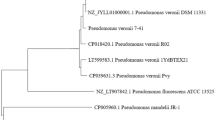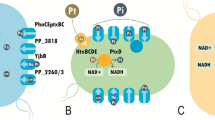Abstract
Plasmid-carrying Pseudomonas putida strains degrade naphthalene through different biochemical pathways. The influence of various combinations of host bacteria and plasmids on growth characteristics and competitiveness of P. putida strains was studied in chemostat culture at a low dilution rate (D=0.05 h−1) with naphthalene as the sole source of carbon and energy. Under naphthalene limitation, the plasmid-bearing strains degrading naphthalene that use catechol 1,2-dioxygenase for catechol oxidation (ortho pathway), were the most competitive. The strains bearing plasmids that control naphthalene catabolism via catechol 2,3-dioxygenase (meta pathway), were less competitive. Under these conditions the strain carrying plasmid pBS4, which encodes for naphthalene catabolism via gentisic acid, was the least competitive.
Similar content being viewed by others
Author information
Authors and Affiliations
Additional information
Received: 24 February 1997 / Received revision: 22 May 1997 / Accepted: 25 May 1997
Rights and permissions
About this article
Cite this article
Filonov, A., Duetz, W., Karpov, A. et al. Competition of plasmid-bearing Pseudomonas putida strains catabolizing naphthalene via various pathways in chemostat culture. Appl Microbiol Biotechnol 48, 493–498 (1997). https://doi.org/10.1007/s002530051085
Issue Date:
DOI: https://doi.org/10.1007/s002530051085




